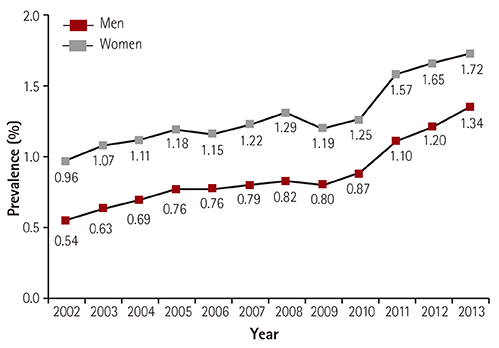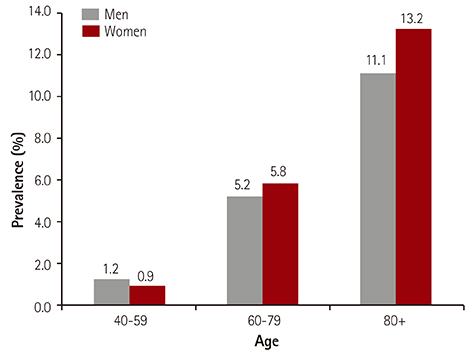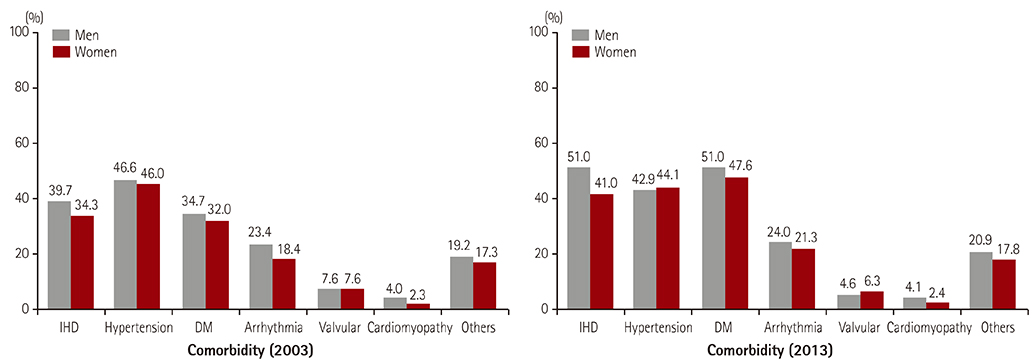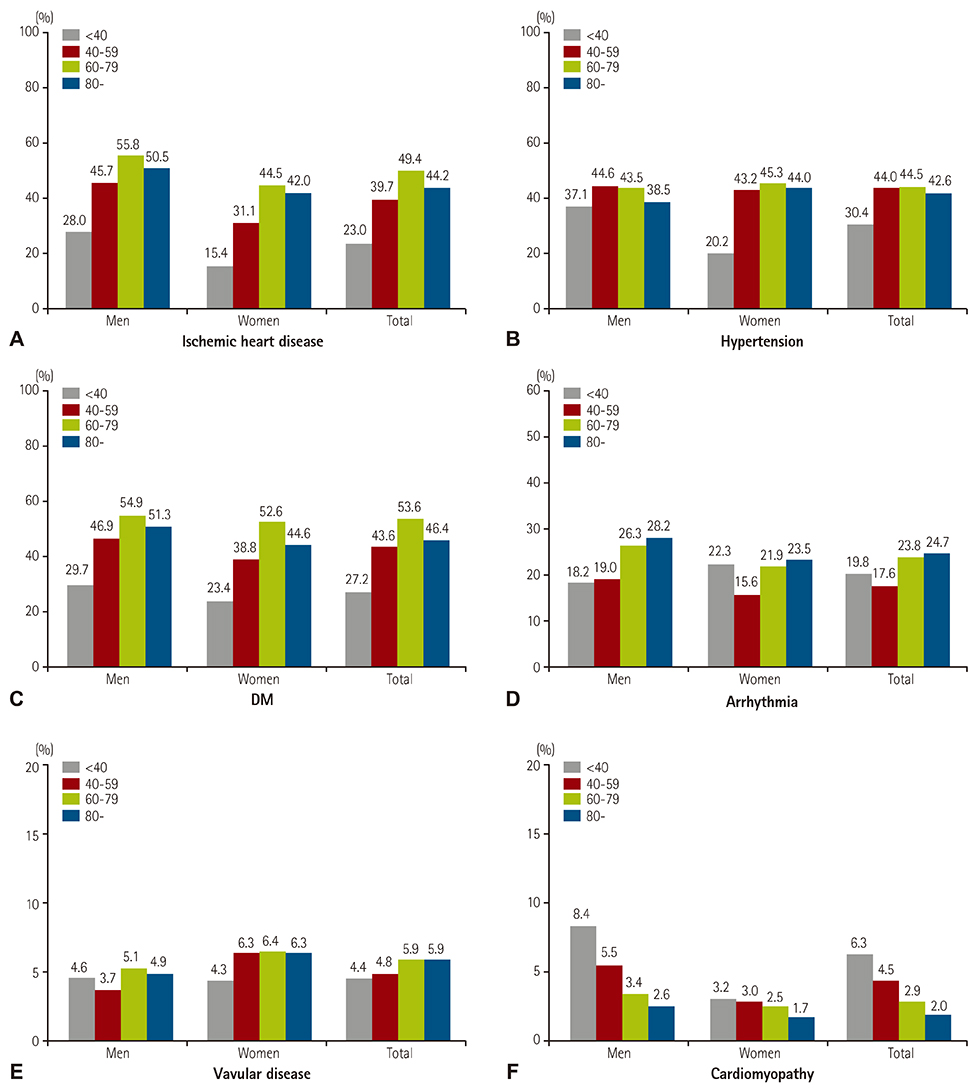Epidemiology of Heart Failure in Korea: Present and Future
- Affiliations
-
- 1Division of Cardiovascular and Rare Diseases, Korea National Institute of Health, Cheongju, Korea. mdhypark@gmail.com
- 2Department of Internal Medicine, College of Medicine, Chungbuk National University, Cheongju, Korea. mccho@cbnu.ac.kr
- KMID: 2389623
- DOI: http://doi.org/10.4070/kcj.2016.46.5.658
Abstract
- BACKGROUND AND OBJECTIVES
Heart failure (HF) is an important healthcare issue because of its high mortality, morbidity, and healthcare costs. The number of HF patients is increasing worldwide as a consequence of aging of the population. However, there are limited studies on the prevalence of HF in Korea. This study aimed to estimate the prevalence of HF, its comorbidities, and the projected population with HF in the future.
MATERIALS AND METHODS
The prevalence and comorbidity estimates of HF were determined using data from the 2002-2013 National Sample Cohort based on the National Health Information Database. We calculated the projected prevalence of HF by multiplying the estimated prevalence in 2013 by the projected population counts for 2015-2040.
RESULTS
The prevalence of HF in Korea was estimated to be 1.53% in 2013. The prevalence of HF in Korea is expected to increase by 2-fold, from 1.60% in 2015 to 3.35% in 2040. By 2040, more than 1.7 million Koreans are expected to have HF. In terms of comorbid diseases of HF, ischemic heart disease, hypertension, and diabetes mellitus were common (45.4%, 43.6%, and 49.1% in 2013, respectively). The prevalence rates of arrhythmia, valvular disease, and cardiomyopathy in HF patients were approximately 22.6%, 5.6%, and 3.1% in 2013, respectively.
CONCLUSION
This is the first nationwide report in Korea to demonstrate the prevalence and comorbidities of HF. These data may be used for the prevention and management of HF in Korea.
Keyword
MeSH Terms
Figure
Cited by 16 articles
-
Clinical Guidelines for Drug-induced Peptic Ulcer, 2020 Revised Edition
Moon Kyung Joo, Chan Hyuk Park, Joon Sung Kim, Jae Myung Park, Ji Yong Ahn, Bong Eun Lee, Jeong Hoon Lee, Hyo-Joon Yang, Yu Kyung Cho, Chang Seok Bang, Beom Jin Kim, Hye-Kyung Jung, Byung-Wook Kim, Yong Chan Lee
Korean J Gastroenterol. 2020;76(3):108-133. doi: 10.4166/kjg.2020.76.3.108.Prevention of Peptic Ulcer Associated with Aspirin and Antiplatelet Agent
Ji Yong Ahn
Korean J Gastroenterol. 2020;76(5):238-241. doi: 10.4166/kjg.2020.140.Letter: Associations among Obesity Degree, Glycemic Status, and Risk of Heart Failure in 9,720,220 Korean Adults (
Diabetes Metab J 2020;44:592-601)
Darae Kim
Diabetes Metab J. 2020;44(5):777-778. doi: 10.4093/dmj.2020.0202.Trends in Cardiovascular Complications and Mortality among Patients with Diabetes in South Korea
Jung Hwan Park, Kyoung Hwa Ha, Bo Yeon Kim, Jae Hyuk Lee, Dae Jung Kim
Diabetes Metab J. 2021;45(1):120-124. doi: 10.4093/dmj.2020.0175.Diabetes Management in Patients with Heart Failure
Jia Shen, Barry H. Greenberg
Diabetes Metab J. 2021;45(2):158-172. doi: 10.4093/dmj.2020.0296.Association between health status and tooth loss in Korean adults: longitudinal results from the National Health Insurance Service-Health Examinee Cohort, 2002–2015
Yeon-Tae Kim, Jung-Kyu Choi, Do-Hyung Kim, Seong-Nyum Jeong, Jae-Hong Lee
J Periodontal Implant Sci. 2019;49(3):158-170. doi: 10.5051/jpis.2019.49.3.158.Korea Heart Disease Fact Sheet 2020: Analysis of Nationwide Data
Hyeok-Hee Lee, So Mi Jemma Cho, Hokyou Lee, Jongmin Baek, Jang-Ho Bae, Wook-Jin Chung, Hyeon Chang Kim
Korean Circ J. 2021;51(6):495-503. doi: 10.4070/kcj.2021.0097.Economic Burden of Heart Failure in Asian Countries Based on Real-world Data
Hyemoon Chung, Il Suk Sohn
Korean Circ J. 2021;51(8):694-695. doi: 10.4070/kcj.2021.0197.Economic Burden of Heart Failure in Asian Countries with Different Healthcare Systems
Teerapat Yingchoncharoen, Tao-Cheng Wu, Dong-Ju Choi, Tiong Kiam Ong, Houng Bang Liew, Myeong-Chan Cho
Korean Circ J. 2021;51(8):681-693. doi: 10.4070/kcj.2021.0029.The Role of Glucagon-Like Peptide 1 Receptor Agonists and Sodium-Glucose Cotransporter 2 Inhibitors in Reducing Cardiovascular Events in Patients with Type 2 Diabetes
Gwang Sil Kim, Joong Hyun Park, Jong Chul Won
Endocrinol Metab. 2019;34(2):106-116. doi: 10.3803/EnM.2019.34.2.106.Healthcare Costs for Acute Hospitalized and Chronic Heart Failure in South Korea: A Multi-Center Retrospective Cohort Study
Hyemin Ku, Wook-Jin Chung, Hae-Young Lee, Byung-Soo Yoo, Jin-Oh Choi, Seoung-Woo Han, Jieun Jang, Eui-Kyung Lee, Seok-Min Kang
Yonsei Med J. 2017;58(5):944-953. doi: 10.3349/ymj.2017.58.5.944.Performance Evaluation of a Point-of-care Test, ‘Samsung LABGEO PA CHF Test’, for the Amino-terminal Pro-brain Natriuretic Peptide
Man Jin Kim, Kyunghoon Lee, Sun-Hee Jun, Sang Hoon Song, Woon Heung Song, Junghan Song
Lab Med Online. 2017;7(3):135-140. doi: 10.3343/lmo.2017.7.3.135.Acute Heart Failure and Its Management
Seonghoon Choi
J Neurocrit Care. 2018;11(1):13-22. doi: 10.18700/jnc.180047.Changes in Patterns of Physical Activity and Risk of Heart Failure in Newly Diagnosed Diabetes Mellitus Patients
Inha Jung, Hyemi Kwon, Se Eun Park, Kyung-Do Han, Yong-Gyu Park, Eun-Jung Rhee, Won-Young Lee
Diabetes Metab J. 2022;46(2):327-336. doi: 10.4093/dmj.2021.0046.Update on the Pharmacotherapy of Heart Failure with Reduced Ejection Fraction
Eui-Soon Kim, Jong-Chan Youn, Sang Hong Baek
Cardiovasc Prev Pharmacother. 2020;2(4):113-133. doi: 10.36011/cpp.2020.2.e17.Korean Society of Heart Failure Guidelines for the Management of Heart Failure: Definition and Diagnosis
Jae Yeong Cho, Dong-Hyuk Cho, Jong-Chan Youn, Darae Kim, Sang Min Park, Mi-Hyang Jung, Junho Hyun, Jimi Choi, Hyun-Jai Cho, Seong-Mi Park, Jin-Oh Choi, Wook-Jin Chung, Byung-Su Yoo, Seok-Min Kang,
Korean Circ J. 2023;53(4):195-216. doi: 10.4070/kcj.2023.0046.
Reference
-
1. Mozaffarian D, Benjamin EJ, Go AS, et al. Heart disease and stroke statistics--2015 update: a report from the American Heart Association. Circulation. 2015; 131:e29–e322.2. Heidenreich PA, Albert NM, Allen LA, et al. Forecasting the impact of heart failure in the United States: a policy statement from the American Heart Association. Circ Heart Fail. 2013; 6:606–619.3. Okamoto H, Kitabatake A. The epidemiology of heart failure in Japan. Nihon Rinsho. 2003; 61:709–714.4. Okura Y, Ramadan MM, Ohno Y, et al. Impending epidemic: Future projection of heart failure in Japan to the year 2055. Circ J. 2008; 72:489–491.5. Shiba N, Nochioka K, Miura M, Kohno H, Shimokawa H. CHART-2 Investigators. Trend of westernization of etiology and clinical characteristics of heart failure patients in Japan--first report from the CHART-2 study. Circ J. 2011; 75:823–833.6. Sakata Y, Shimokawa H. Epidemiology of heart failure in Asia. Circ J. 2013; 77:2209–2217.7. Pillai HS, Ganapathi S. Heart failure in South Asia. Curr Cardiol Rev. 2013; 9:102–111.8. Guo Y, Lip GY, Banerjee A. Heart failure in East Asia. Curr Cardiol Rev. 2013; 9:112–122.9. Statistics Korea. Population projections for Korea: 2010-2060 (based on the 2010 census). Daejeon: Statistics Korea;2011.10. Khatibzadeh S, Farzadfar F, Oliver J, Ezzati M, Moran A. Worldwide risk factors for heart failure: A systematic review and pooled analysis. Int J Cardiol. 2013; 168:1186–1194.11. Adams KF Jr, Fonarow GC, Emerman CL, et al. Characteristics and outcomes of patients hospitalized for heart failure in the United States: Rationale, design, and preliminary observations from the first 100,000 cases in the Acute Decompensated Heart Failure National Registry (ADHERE). Am Heart J. 2005; 149:209–216.12. Abraham WT, Fonarow GC, Albert NM, et al. Predictors of in-hospital mortality in patients hospitalized for heart failure: Insights from the Organized Program to Initiate Lifesaving Treatment in Hospitalized Patients with Heart Failure (OPTIMIZE-HF). J Am Coll Cardiol. 2008; 52:347–356.13. Yang YN, Ma YT, Liu F, et al. Incidence and distributing feature of chronic heart failure in adult population of Xinjiang. Zhonghua Xin Xue Guan Bing Za Zhi. 2010; 38:460–464.14. Chong AY, Rajaratnam R, Hussein NR, Lip GY. Heart failure in a multiethnic population in Kuala Lumpur, Malaysia. Eur J Heart Fail. 2003; 5:569–574.15. Schocken DD, Benjamin EJ, Fonarow GC, et al. Prevention of heart failure: a scientific statement from the American Heart Association Councils on Epidemiology and Prevention, Clinical Cardiology, Cardiovascular Nursing, and High Blood Pressure Research; Quality of Care and Outcomes Research Interdisciplinary Working Group; and Functional Genomics and Translational Biology Interdisciplinary Working Group. Circulation. 2008; 117:2544–2565.16. Owan TE, Hodge DO, Herges RM, Jacobsen SJ, Roger VL, Redfield MM. Trends in prevalence and outcome of heart failure with preserved ejection fraction. N Engl J Med. 2006; 355:251–259.17. Bhatia RS, Tu JV, Lee DS, et al. Outcome of heart failure with preserved ejection fraction in a population-based study. N Engl J Med. 2006; 355:260–269.18. Shiba N, Shimokawa H. Chronic heart failure in Japan: Implications of the CHART studies. Vasc Health Risk Manag. 2008; 4:103–113.19. Choi DJ, Han S, Jeon ES, et al. Characteristics, outcomes and predictors of long-term mortality for patients hospitalized for acute heart failure: a report from the Korean heart failure (KorHF) registry. Korean Circ J. 2011; 41:363–371.20. Lee SE, Cho HJ, Lee HY, et al. A multicentre cohort study of acute heart failure syndromes in Korea: rationale, design, and interim observations of the Korean Acute Heart Failure (KorAHF) registry. Eur J Heart Fail. 2014; 16:700–708.21. Mosterd A, Hoes AW. Clinical epidemiology of heart failure. Heart. 2007; 93:1137–1146.22. Kajimoto K, Sato N, Keida T, et al. investigators of the Acute Decompensated Heart Failure Syndromes (ATTEND) registry. Association between length of stay, frequency of in-hospital death, and causes of death in Japanese patients with acute heart failure syndromes. Int J Cardiol. 2013; 168:554–556.23. Abraham WT, Fonarow GC, Albert NM, et al. OPTIMIZE-HF Investigators and Coordinators. Predictors of in-hospital mortality in patients hospitalized for heart failure: insights from the Organized Program to Initiate Lifesaving Treatment in Hospitalized Patients with Heart Failure (OPTIMIZE-HF). J Am Coll Cardiol. 2008; 52:347–356.24. Nieminen MS, Brutsaert D, Dickstein K, et al. EuroHeart Survey Investigators. Heart Failure Association, European Society of Cardiology. EuroHeart Failure Survey II (EHFS II): A survey on hospitalized acute heart failure patients: Description of population. Eur Heart J. 2006; 27:2725–2736.25. Hamaguchi S, Kinugawa S, Tsuchihashi-Makaya M, et al. JCARE-CARD Investigators. Loop diuretic use at discharge is associated with adverse outcomes in hospitalized patients with heart failure: A report from the Japanese cardiac registry of heart failure in cardiology (JCARE-CARD). Circ J. 2012; 76:1920–1927.26. Kannel WB, Ho K, Thom T. Changing epidemiological features of cardiac failure. Br Heart J. 1994; 72:2 Suppl. S3–S9.27. He J, Ogden LG, Bazzano LA, Vupputuri S, Loria C, Whelton PK. Risk factors for congestive heart failure in US men and women: NHANES I epidemiologic follow-up study. Arch Intern Med. 2001; 161:996–1002.
- Full Text Links
- Actions
-
Cited
- CITED
-
- Close
- Share
- Similar articles
-
- Optimal Management of Heart Failure with Preserve Ejection Fraction
- Gene Therapy for Heart Failure
- Beta-Blockers in Heart Failure with Preserved Ejection Fraction: Could Their Use Be Vindicated as an Acceptable Option in the Future Treatment Guideline?
- Recent Advancement in Heart and Lung Transplantation
- Key Role of the Korean Society of Heart Failure: Moving Towards a Global and Individualized Approach





